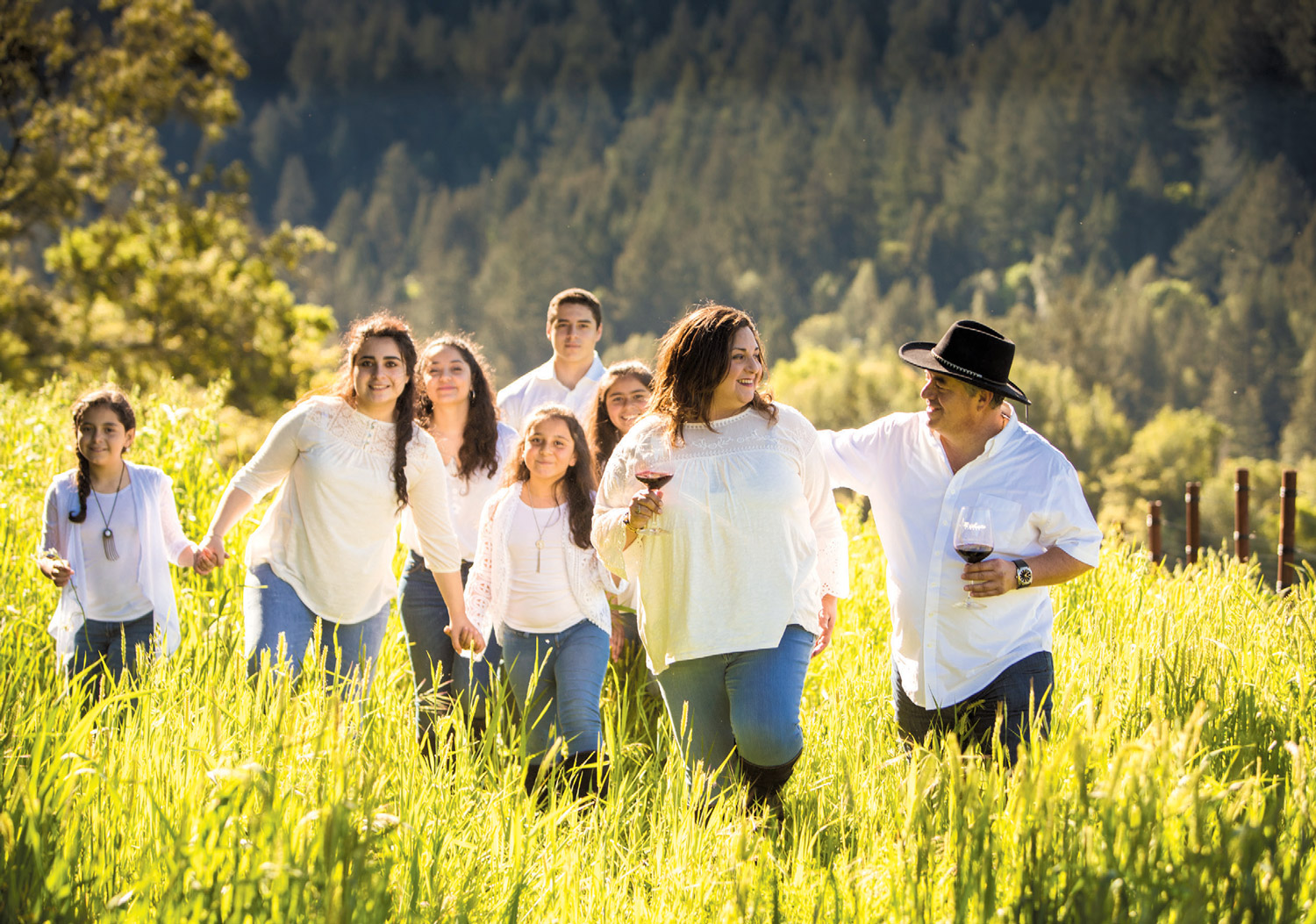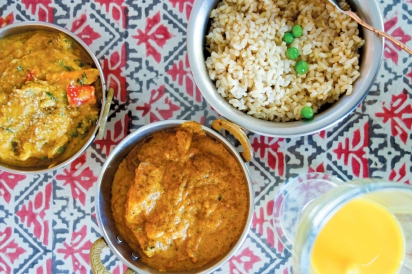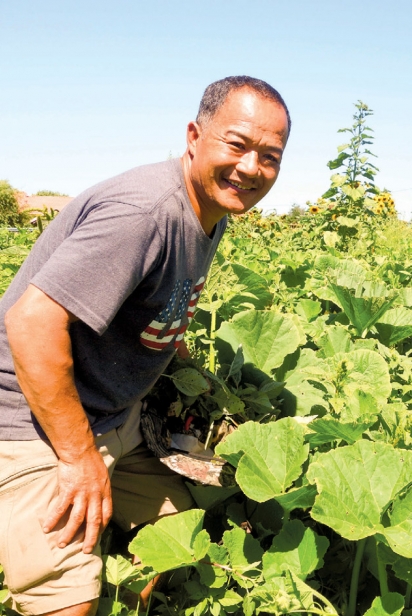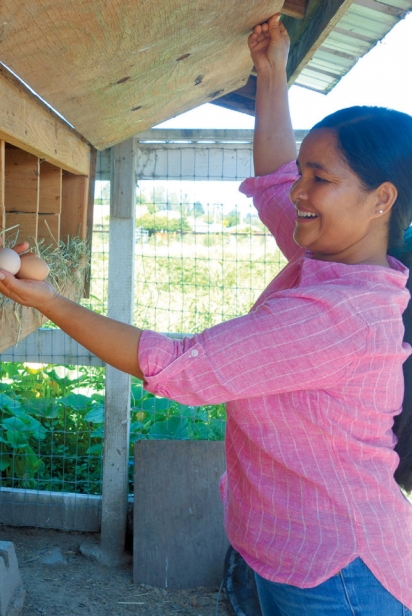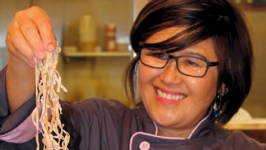Farm to Table
LONG BEFORE IT WAS A SLOGAN, IT WAS A WAY OF LIFE
Blame my Berkeley origins, but the immediate imagery I associate with the phrase “farm-to-table” is Alice Waters in a purple garlic flower crown ladling soup at 1970s Chez Panisse. But for many people around the world, farm-to-table is not a social movement or a trend, and it definitely is not something they learned about in a restaurant. It’s a way of life, and often the phrase describes their daily means of survival.
Here in Northern California, our understanding of farm-to-table is made richer by the various experiences layered upon the phrase, often by people who came here from around the world to fuel and better the food industry here. In this piece I asked three immigrants to our area about their relationship to farming and food, beginning in their home countries and evolving to the present. I started with the question: What does “farm-to-table” mean to you?
ROLANDO HERRERA, MEXICO
Rolando Herrera’s family first immigrated to the U.S. when he was 8 years old. Five years later they returned to Mexico. Herrera, wanting to pursue his education, decided to come back to the Napa Valley on his own at age 15, putting himself through school while working at night and during the summers. While hammering rocks for a masonry wall at Stag’s Leap Winery, his work ethic caught the attention of owner Warren Winiarski. His first day working in wine operations at Stag’s Leap was the first day of his senior year of high school, and he remembers immediately being hooked by the aromas of wine and oak. He worked his way up in the industry, and in 1997 opened Mi Sueño Winery. (He also got married that year.) Herrera also has his own vineyard management company, owns 40 acres of vineyards and makes wine for other boutique brands. Mi Sueño translates to “my dream.” I interviewed him at the winery and warehouse in an industrial park in Napa.
“I was born and raised in Michoacan, in a small village named El Llano, which prior to becoming a village was a hacienda. It’s a very humble, poor town.
“My grandmother from my mom’s side, she was an entrepreneur. I didn’t discover that until about four years ago, which now helps me answer some of the questions about where my business sense comes from. She would sell kerosene, handmade tortillas, pots and pottery. She was just doing whatever she could. My grandfather had two donkeys and he would go to the hills and bring two or three loads of wood to sell, but one was always for my grandma—back then you cooked everything with fire.
“So, this was humble, hard work, living one day at a time. There were times in the winter where I remember complaining as a kid of being tired of eating so many potatoes and onions. There were days when it was just potatoes with salt and lemon for lunch. You know in Mexico we eat everything with salt and lemon, right? Those were the sad parts that I remember, but I really appreciate them because I think they shaped where I am today. But when the times were good, food is such a big part of the culture, we always had lunch and dinner together. A big day was on Sunday; that’s when you would have a stew with chicken or beef or a slice of carne asada. It was humble, but there was always food.
“I would say I was born and raised in the fields, seeing my grandparents harvest their corn.
I would hate going to the ecuaros—more walking in the mountains, more weeds to pull, more rocks to go through. [Ecuaro means “hillside plot” in the indigenous language Purépecha]. I would say, ‘Grandma, why do we have to go so far to plant corn and pumpkins here when you have your land?’ And she would say, ‘Mijo, the land we have down there, that’s for us to plant our crops to sell, so we can live off that for the rest of the year. This ecuaro, we plant stuff here for us to eat and this is better, there’s the hillside, and the wind and the sun and soil.’ I thought she was just making things up. And she wasn’t, you know?
“Those lessons in life early on, I can’t tell you how much they’ve helped me feel comfortable and embrace the wine industry. It’s made me feel at home and that’s what’s given me the comfort, the courage, the trust in myself to be who I am today, to start a vineyard management company without ever doing it before, plant vineyards without ever doing it before, grow my own vines without any experience, because I feel at home. I remember hearing consultants from Australia and Europe come here to talk a lot about the sun and the air and the soil and I remember to saying to myself, ‘Wow! Really? These guys make all this money? My grandma taught me that a long time ago.’ Just applying that knowledge and my passion and intuition has allowed me to own my own vineyards and company. I’m really lucky and very proud and thankful to my grandparents for dragging me to those fields.”
MEI IBACH, MALAYSIA
Deemed a spinster for being unmarried in her late 20s, Mei Ibach left her real estate job in Kuala Lumpur for the U.S. on a student visa. She enrolled in community college, and poetically, has returned to Santa Rosa Junior College for the most recent chapter of her life as a culinary instructor. Cooking is a relatively new career, a passion she followed after working as an early childhood educator. She teaches private classes, leads culinary tours and is also a chef and instructor for Fresh Starts, a culinary and job skills training program of Homeward Bound Marin. I interviewed her in her office there, after a tour of the campus garden where the first of the summer lettuces were beginning to sprout.
“I grew up in a little fishing village about a two-hour drive from Singapore on the south tip of Malaysia. We grew everything, from raising the chickens to growing watermelons. We were very poor because my family were immigrants from the south of China: My mom was brought to Malaysia when she was 6 years old as a servant, and she was illiterate and wasn’t able to go to school. So growing up was all about growing your own food.
“Every morning we would go collect the eggs from the chickens. We were so poor that meat was a luxury, we would only have chicken once a year, on Chinese New Year. I always remember having to catch the chicken, and once you have the chicken and blanch the chicken, then you just stand there and pluck the feathers for about three hours. By the time you cook it and bring it to the table it tastes so good, you can taste the sweetness in the bones because you spent all that time, from raising it to cooking it, and you have a different respect for the food that goes into your body because you have that gratitude, that connection.
“We were poor but we never realized we were poor because we would go collect clams in the evening when it was low tide, we would get crabs on the beach, the fishing boats would come in every day and we would just stand there and they would just throw the fish out of the boats for us to catch them. But I had gotten to the point that I never wanted to eat fish for the rest of my life.
“There was never any urgency to cook in my family. If anybody had to cook, it was my mother, but she was the worst cook in the world! Malaysia and Singapore are street food heaven—you can just walk out your doorstep and there will be the best street food on the corner. You can get a bowl of delicious noodles for 50 cents.
“When we did cook we had a communal kitchen in the compound of the village and women would come and cook together, so as a little kid you always had to help chop or do some dishes. There were no recipes, but talk about gossip! It was always happening in the kitchen. But it’s that community, that culture of sharing, and the cooking that instilled in me a real passion for food.
“I think when I came to the U.S. and when I first started teaching, I found that lot of young people were so sheltered from where real food comes from. When you talk about bacon, they had no idea it came from pork. I mean, 20 years ago I couldn’t find coconut milk, and the best restaurant in Sonoma was serving canned vegetables. So when I became a chef I knew I wanted to work in teaching. My calling was to help show people that it’s important to know where your food comes from.
“I teach some of the most broken populations at Homeward Bound, people who have been incarcerated, living in their cars, everyone has a really profound story about where they come from, and they just want a second chance. And to do something in food—who doesn’t like food? People say ‘Yes, I love to cook’ or ‘I learned to cook from my grandmother’— there’s an immediate connection to where you came from. And they could be in their 20s or 40s and they are seeing for the first time where their food comes from. To me, it’s powerful.
“As I got more and more into it I realized I can’t affect everyone’s life, but if I can just get one good student that has the passion and love for food and then can do something with that training, I’m going to take that person under my wing. And I’ve seen some profound impacts. So that’s what motivates me and inspires me. It’s the time in my life to give back and do something meaningful that will create an impact from this generation to the next generation.”
RAJET AND RAMA MOKTAN, NEPAL
Rajet and Rama Moktan are the owners of Himalayan Tandoori and Curry House in Sebastopol. Nearby, at their home and two and a half acre farm, they grow produce for the restaurant; raise pigs, chickens and goats; and grow sunflowers that tower over chamomile flowers. The couple and their two sons escaped the civil war in Nepal, arriving in Daly City, then Berkeley, and finally settling in the North Bay. I interviewed them over a cup of black tea sweetened with milk and honey at their home, where they live with their two kids, daughters-in- law and 2-month-old granddaughter.
Rajet: “We grew up in the same place north of Kathmandu. We were from farming families. I moved to the city when I was 14. We farmed corn, beans, potatoes, millet, barley and all the greens. We had animals: water buffalo, cows and goats. It was just for our family; at that time we didn’t have a market to sell to. We survived like that. I remember my grandmother made our own clothes with cotton.”
Rama: “We were not poor, but we were not rich. I came to Kathmandu when I was 13 years old, and that was when my dad died. My mom had five kids, so one of my god-dads supported me. Rajet and I were on our own and we married, because at that time there was no girlfriend and boyfriend. Once you knew each other you had to marry. We married and along came our baby boy. We were hard workers, but we never had a dream that we would have a big farm or restaurant.
“In 1996, Nepal had a civil war. That’s why we came to the U.S. Rajet came with $1,500, and I came later with the kids and another $3,500. When we arrived here, I saw that time is money. So we worked days and nights, switching off and on, so one of us could be with the kids.”
Rajet: “I used to work two jobs, 70 hours a week. You know that rotisserie guy that sells chickens at the farmers’ market? I used to work with him 12 to 14 hours, and after that I would work at Home Depot. For four years I didn’t take a day off. Rama worked as a nanny and never took a day off.”
Rama: “And then we saved some money and we were, like, ‘OK, let’s do something.’ Someone was selling the restaurant in Sebastopol, so we thought ‘Let’s try selling Nepalese food.’”
Rajet: “Starting was challenging because it was 2007, when the market crashed, but our community and our customers were excited about our food because it was different and organic. We still have the same customers.”
Rajet: “We moved into our house here in 2011 and remodeled, working here and there, then we started gardening. We got a pig and then goats.”
Rama: “We use the compost from our veggies to feed the animals. That’s how we did it when we grew up.”
Rajet: “America has a different food system. There is too much pesticide here, the food looks good but there’s a different quality in taste. That’s one thing I that I have—lots of people don’t know how to grow their own food here.”
Rama: “Farm-to-table means you pick things and cook every morning. We didn’t have a refrigerator or electricity at home, so we cooked what we picked. Here, you get food from grocery stores and I don’t know where it comes from or how it’s stored. Children don’t know where their food is from. We will love to teach our grandkids how to plant their own vegetables and raise their own meat. America was a big opportunity for us. This is the land of honey and milk, and we came for it, so we would like to give that blessing to our grandkids.”


